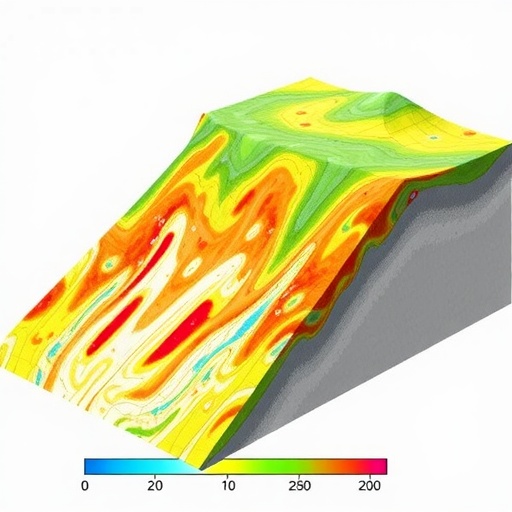In a groundbreaking development poised to revolutionize geotechnical engineering and hazard prediction, researchers have introduced an intelligent combined prediction system designed to assess the instability of slopes prone to rainfall-induced failure. This pioneering system, meticulously engineered to tackle the complex interplay of natural forces causing soil and rock slope destabilization, is set to significantly advance our capacity to forecast and mitigate landslides, a persistent geohazard threatening communities worldwide.
Slope failures triggered by intense rainfall remain among the most destructive natural disasters, often resulting in catastrophic loss of life and property. Traditional predictive models have struggled to capture the multifaceted dynamics of slope behavior under variable hydrological and mechanical stresses. These systems frequently fall short due to the inherent complexity of natural slopes, variability in soil properties, and the nonlinear nature of failure mechanisms under sustained or intense precipitation events.
The new intelligent prediction system spearheaded by Wu, Gan, Yang, and their colleagues leverages a sophisticated ensemble of analytical methods and machine learning algorithms, meticulously calibrated to synthesize a wide array of geotechnical data inputs. The core innovation lies in its ability to merge signal processing techniques, geomechanical analysis, and artificial intelligence, creating a cohesive framework that interprets subtle changes in slope stability indicators and forecasts failure probabilities with unprecedented accuracy.
Central to this approach is the utilization of a combined prediction mechanism that integrates real-time rainfall data, soil moisture content measurements, and intrinsic slope parameters such as cohesion, angle of internal friction, and geometry. By dynamically analyzing these inputs, the system can detect critical thresholds and evolving instability patterns that precede a slope failure event. This nuanced understanding enables earlier and more reliable warnings, providing crucial lead time for mitigation actions.
The team’s research highlights a detailed process by which rainfall infiltration alters the pore water pressure within slope materials, diminishing effective stress and weakening the soil matrix. The intelligent model captures these hydromechanical interactions explicitly, accounting for the nonlinear response of soil strength to changing moisture conditions. This comprehensive depiction marks a departure from conventional linearized models, embracing the complexity inherent in soil mechanics.
Implementation of this intelligent prediction system involved rigorous validation against historical landslide events and controlled experimental datasets. The results demonstrated a marked improvement in recognition of early failure signals compared to existing predictive tools. Notably, the model maintained robustness across varying slope types and soil stratifications, showcasing its adaptability and wide applicability.
Critical to the model’s success is its hybrid architecture combining machine learning classifiers with deterministic slope stability analysis. The machine learning component excels at detecting patterns and anomalies in large, multivariate datasets, while the deterministic layer ensures that physical laws governing soil behavior constrain and inform predictions, preventing spurious outputs often associated with purely data-driven methods.
Moreover, the research delves into the system’s capacity for continuous learning and self-optimization. As new data streams—such as updated rainfall measurements or pore pressure readings—become available, the system iteratively refines its prediction accuracy. This feature embodies a shift toward intelligent, adaptive monitoring systems capable of evolving alongside changing environmental conditions and improving their hazard assessment efficacy over time.
Beyond the technical prowess, this work carries profound implications for disaster risk management. Communities residing in mountainous or hilly terrain often grapple with inadequate early warning systems. By integrating this intelligent combined prediction system into existing geotechnical monitoring networks, authorities can issue more timely and reliable alerts, potentially saving lives and reducing economic losses.
Furthermore, the model’s ability to simulate various scenarios under different rainfall intensities and durations offers planners valuable insights into the resilience of infrastructure and land use configurations. It facilitates proactive strategy development, guiding engineering designs, and emergency preparedness plans tailored to region-specific geotechnical vulnerabilities.
The multidisciplinary approach adopted by Wu and colleagues, blending geotechnical science, hydrology, artificial intelligence, and data analytics, exemplifies the contemporary trajectory of environmental hazard research. This synergy has yielded a tool that transcends traditional disciplinary boundaries, promising a new era in predictive geomechanics.
Importantly, the system is designed with user-friendliness and real-time operational integration in mind. Its computational efficiency enables deployment in both urban and remote environments, accommodating the varied technological capacities of different regions. This democratization of predictive technology enhances global accessibility and fosters resilience in developing areas often hardest hit by landslides yet least equipped to respond.
Environmental Earth Sciences, the journal publishing this work, underscores the relevance and timeliness of this contribution amid escalating climate change impacts. As rainfall patterns become more erratic and extreme, the frequency and severity of rainfall-induced slope failures are anticipated to rise, intensifying the demand for sophisticated, intelligent prediction tools such as this one.
In essence, this intelligent combined prediction system embodies a paradigm shift. It moves beyond static assessments, dynamically interfacing with real-world data streams to create a living model of slope stability. This represents a leap forward from conventional slope stability evaluations toward a proactive, anticipatory framework capable of informing real-time risk mitigation.
The researchers anticipate future extensions, including incorporation of remote sensing data and wider geographical calibration for global applicability. Such advancements could extend the model’s utility, allowing for multinational collaborative efforts in landslide risk reduction and boosting disaster preparedness on an international scale.
In sum, this innovative system not only enhances technical understanding of rainfall-induced slope failures but also promises practical, life-saving applications. Its blend of scientific rigor and cutting-edge technology signals a thrilling horizon in earth science and hazard mitigation, reinforcing the critical importance of interdisciplinary ingenuity in confronting planetary challenges.
Subject of Research: Rainfall-induced instability of circular failure slopes and intelligent prediction models.
Article Title: A new intelligent combined prediction system for rainfall-induced instability of circular failure slopes.
Article References:
Wu, L., Gan, F., Yang, R. et al. A new intelligent combined prediction system for rainfall-induced instability of circular failure slopes. Environ Earth Sci 84, 585 (2025). https://doi.org/10.1007/s12665-025-12569-7
Image Credits: AI Generated




